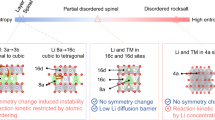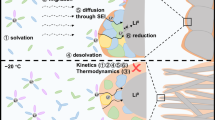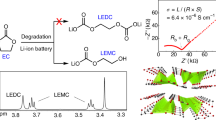Abstract
The rechargeable lithium-ion cell is an advanced energy-storage system. However, high cost, safety hazards, and chemical instability prohibit its use in large-scale applications. An alternative cathode material, LiFePO4, solves these problems, but has a kinetic problem involving strong electron/hole localization1. One reason for this is believed to be the limited carrier density in the fixed monovalent Fe3+PO4/LiFe2+PO4 two-phase electrode reaction in LixFePO4. Here, we provide experimental evidence that LixFePO4, at room temperature, can be described as a mixture of the Fe3+/Fe2+ mixed-valent intermediate LiαFePO4 and Li1−βFePO4 phases. Using powder neutron diffraction, the site occupancy numbers for lithium in each phase were refined to be α=0.05 and 1−β=0.89. The corresponding solid solution ranges outside the miscibility gap (0<x<α,1−β<x<1) were detected by the anomaly in the configurational entropy, and also by the deviation of the open-circuit voltage from the constant equilibrium potential. These findings encourage further improvement of this important class of compounds at ambient temperatures.
This is a preview of subscription content, access via your institution
Access options
Subscribe to this journal
Receive 12 print issues and online access
$259.00 per year
only $21.58 per issue
Buy this article
- Purchase on Springer Link
- Instant access to full article PDF
Prices may be subject to local taxes which are calculated during checkout



Similar content being viewed by others
References
Padhi, A. K., Nanjundaswamy, K. S. & Goodenough, J. B. Phospho-olivines as positive-electrode materials for rechargeable lithium batteries. J. Electrochem. Soc. 144, 1188–1194 (1997).
Yamada, A. & Yamahira, T. Cathode for nonaqueous electrolyte lithium battery. European patent 1150368 (2001).
Yamada, A., Chung, S.-C. & Hinokuma, K. Optimized LiFePO4 for lithium battery cathode. J. Electrochem. Soc. 148, A224–A229 (2001).
Chung, S. Y., Bloking, J. T. & Chiang, Y. M. Electronically conductive phospho-olivines as lithium storage electrode. Nature Mater. 1, 123–128 (2002).
Subramanya Herle, P., Ellis, B., Coombs, N. & Nazar, L. Nano-network electronic conduction in iron and nickel olivine phosphates. Nature Mater. 3, 147–152 (2004).
Dahn, J. R. & McKinnon, W. R. Phase diagram of LixMo6Se8 for 0<x<1 from in situ x-ray studies. Phys. Rev. B 32, 3003–3005 (1985).
Dahn, J. R. et al. Entropy of the intercalation compound LixMo6Se8 from calorimetry of electrochemical cells. Phys. Rev. B 32, 3316–3318 (1985).
Delmas, C., Nadiri, A. & Soubeyroux, J. L. The NASICON-type titanium phosphates ATi2(PO4)3 (A=Li,Na) as electrode materials. Solid State Ionics 28–30, 419–423 (1988).
Delacourt, C., Poizot, P., Tarascon, J. M. & Masquelier, C. The existence of a temperature-driven solid solution in LixFePO4 for 0<x<1 . Nature Mater. 4, 254–260 (2005).
Andersson, A. S., Kalska, B., Häggström, L. & Thomas, J. O. Lithium extraction/insertion in LiFePO4: an X-ray diffraction and Mössbauer spectroscopy study. Solid State Ionics 130, 41–52 (2000).
Yamada, A., Koizumi, H., Sonoyama, N. & Kanno, R. Phase change in LixFePO4 . Electrochem. Solid State Lett. 8, A409–A413 (2005).
Kobayashi, Y. et al. Precise electrochemical calorimetry of LiCoO2/graphite lithium-ion cell—Understanding thermal behavior and estimation of degradation mechanism. J. Electrochem. Soc. 149, A978–A982 (2002).
Kobayashi, Y. et al. Electrochemical and calorimetric approach to spinel lithium manganese oxide. J. Power Sources 81, 463–466 (1999).
Reynier, Y. et al. Entropy of Li intercalation in LixCoO2 . Phys. Rev. B 70, 174304 (2004).
Srinivasan, V. & Newman, J. Existence of path-dependence in the LiFePO4 electrode. Electrochem. Solid State Lett. 9, A110–A114 (2006).
Morgan, D., Van der Ven, A. & Ceder, G. Li conductivity in LixMPO4 (M=Mn,Fe,Co,Ni) olivine materials. Electrochem. Solid State Lett. 7, A30–A32 (2004).
Zhou, F., Marianetti, C. A., Cococcoini, M., Morgan, D. & Ceder, G. Phase separation in LixFePO4 induced by correlation effects. Phys. Rev. B 69, 201101 (2004).
Yamada, A., Kudo, Y. & Liu, K. Y. Phase diagram of Lix(MnyFe1−y)PO4 (0<x,y<1) . J. Electrochem. Soc. 148, A1153–A1158 (2001).
Yamada, A., Kudo, Y. & Liu, K. Y. Reaction mechanism of the olivine-type Lix(Mn0.6Fe0.4)PO4(0<x<1) . J. Electrochem. Soc. 148, A747–A754 (2001).
Yamada, A. & Chung, S.-C. Crystal chemistry of the olivine-type Li(MnyFe1−y)PO4 and (MnyFe1−y) PO4 as possible 4 V cathode materials for lithium batteries. J. Electrochem. Soc. 148, A960–A967 (2001).
Yamada, A. et al. Electrochemical, magnetic, and structural investigation of the Lix(MnyFe1−y)PO4 phases. Chem. Mater. 18, 804–813 (2006).
Acknowledgements
The authors would like to thank H. Miyashiro, S. Seki and Y. Ohno for enlightening discussions. This work was financially supported by the TEPCO Research Foundation, the Murata Science Foundation, Grant-in-Aid for Scientific Research from the Ministry of Education, Culture, Sports, Science and Technology, No. 16350108, and the New Energy and Industrial Technology Development Organization (NEDO).
Author information
Authors and Affiliations
Corresponding author
Ethics declarations
Competing interests
The authors declare no competing financial interests.
Supplementary information
Supplementary Information
Supplementary figures S1 - S4 and tables S1 - S2 (PDF 318 kb)
Rights and permissions
About this article
Cite this article
Yamada, A., Koizumi, H., Nishimura, Si. et al. Room-temperature miscibility gap in LixFePO4. Nature Mater 5, 357–360 (2006). https://doi.org/10.1038/nmat1634
Received:
Accepted:
Published:
Issue Date:
DOI: https://doi.org/10.1038/nmat1634
This article is cited by
-
Learning heterogeneous reaction kinetics from X-ray videos pixel by pixel
Nature (2023)
-
High redox potential transition metals incorporated olivine structure: LiFe0.7(Mn1/3Co1/3Ni1/3)3x−yVyPO4 (x = 0.1, 0.0 ≤ y ≤ 0.10) cathode for Li-ion battery
Ionics (2023)
-
The role of solid solutions in iron phosphate-based electrodes for selective electrochemical lithium extraction
Nature Communications (2022)
-
Correlative image learning of chemo-mechanics in phase-transforming solids
Nature Materials (2022)
-
Nanostructuring versus microstructuring in battery electrodes
Nature Reviews Materials (2022)



